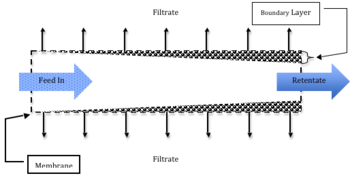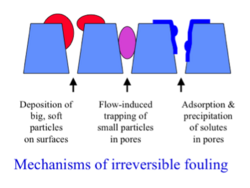Crossflow membrane filtration: Difference between revisions
imported>Justin D. Finkle |
imported>Justin D. Finkle No edit summary |
||
| Line 1: | Line 1: | ||
Crossflow filtration is a term used to refer to a membrane filtration technique in which feed flows parallel to the membrane, rather than perpendicular to the membrane as in conventional filtration.<ref name=Harrison2003> Harrison, Roger G., et al (2003). Bioseparations science and Engineering. New York: Oxford University Press. </ref> It is typically characterized by having high tangential fluid velocity and a low velocity normal to the membrane. Crossflow filtration is used in many applications of downstream processing including food processing, pharmaceutical production, and cell separation. | Crossflow filtration is a term used to refer to a membrane filtration technique in which feed flows parallel to the membrane, rather than perpendicular to the membrane as in conventional filtration.<ref name=Harrison2003> Harrison, Roger G., et al (2003). Bioseparations science and Engineering. New York: Oxford University Press. </ref> It is typically characterized by having high tangential fluid velocity and a low velocity normal to the membrane. Crossflow filtration is used in many applications of downstream processing including food processing, pharmaceutical production, and cell separation. This type of separation is typically used because of it is simple, cost effective, and has high throughput rates. | ||
==Comparison with conventional filtration== | ==Comparison with conventional filtration== | ||
Revision as of 16:25, 14 December 2010
Crossflow filtration is a term used to refer to a membrane filtration technique in which feed flows parallel to the membrane, rather than perpendicular to the membrane as in conventional filtration.[1] It is typically characterized by having high tangential fluid velocity and a low velocity normal to the membrane. Crossflow filtration is used in many applications of downstream processing including food processing, pharmaceutical production, and cell separation. This type of separation is typically used because of it is simple, cost effective, and has high throughput rates.
Comparison with conventional filtration
In an ideal crossflow filtration system the flux of permeate through the membrane will reach a steady state. This allows for much easier continuous removal of the target material when compared with conventional filtration. In practical applications, though, a cake builds up along the membrane, increasing in thickness further down the filter, as shown on the diagram to the right.
Additionally, because the fluid flow is parallel to the membrane—rather than normal to it as in a conventional filtration system—shear along the membrane prevents continual cake buildup. This contributes to the easy and continuous removal of the target material and reduces the need for cake washing. Fouling of the membrane can still occur along with concentration polarization
Membrane fouling
Though fouling is significantly reduced in crossflow membrane systems, as compared with conventional filtration systems, it is still a problem. Depending on the type of filter used and the pore sizes, different problems can arise. Concentration polarization can become exacerbated by gel formation in ultrafiltration systems, and microfiltration of suspended particles can create
thick cake layers that reduce transmembrane flux.[1] Large, soft particles can adhere to the pores, smaller particles can clog pores, and precipitates can form on the pores all reducing the pore size available and reducing transmembrane flux. Types of pore plugging can be seen in Figure 3 to the left. Gel layer formation can sometimes be reduced by mechanical agitation. [2]
Typical Operation
Dissolved Species
As the feed flows across the membrane, dissolved molecules will be rejected by the membrane. When this occurs, a concentration gradient develops along the membrane where molecules are in higher concentrations than that of the solution. Membranes with small enough pore sizes, such as those used in ultrafiltration, can even remove dissolved species and form a gel layer that impedes transmembrane flux. [2]
Suspended Species
Crossflow membrane filtration that involves suspended particles will generate a cake layer that is similar to the gel layer of an ultrafiltration system and is shown in Figure 1. [1] The cake layer will continue to increase, constricting the fluid flow channel and reducing transmembrane flux of the filtrate until steady state is reached. For particles greater than 1μm in diameter typical dissolved species flux equation is no longer valid and shear-induced diffusion theory created by Zydney and Colton can be used.[1]
Concentration Polarization
Applications of crossflow filtration
Many different types of filtration exist that are specific to different particle sizes. Choosing the appropriate one depends on the target that is being selected for and the key impurities that will be removed. Different types of filters are shown in the table below and include: microfiltration, ultrafiltration, nanofiltration, and reverse osmosis.
| Size | Molecular Weight | Example Particle | Membrane Process |
|---|---|---|---|
| 100 μm | Pollen | Microfiltration | |
| 10μm | Starch | Microfiltration | |
| 1μm | Blood Cells, Bacteria | Microfiltration | |
| 100Å | 100,000 | Albumin, Pepsin | Ultrafiltration |
| 10Å | 1,000-10,000 | Vitamin B12, Glucose | Ultrafiltration, Nanofiltration |
| 1Å | Water, Sodium Chloride | Reverse Osmosis |
One particular type of crossflow membrane device is the hollow fiber membrane. In hollow fiber filter systems, the feed flow is run through many tiny hollow tubes and molecules are allowed to diffuse in and out normal to the fluid flow through the tubes. This is commonly used in dialysis of human blood.

